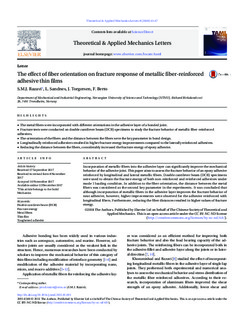| dc.contributor.author | Javad Razavi, Seyed Mohammed | |
| dc.contributor.author | Sandnes, Lise | |
| dc.contributor.author | Torgersen, Jan | |
| dc.contributor.author | Berto, Filippo | |
| dc.date.accessioned | 2018-08-13T12:02:21Z | |
| dc.date.available | 2018-08-13T12:02:21Z | |
| dc.date.created | 2018-01-24T19:36:19Z | |
| dc.date.issued | 2018 | |
| dc.identifier.citation | Theoretical and Applied Mechanics Letters. 2018, 8 (1), 43-47. | nb_NO |
| dc.identifier.issn | 2095-0349 | |
| dc.identifier.uri | http://hdl.handle.net/11250/2557751 | |
| dc.description.abstract | Incorporation of metallic fibers into the adhesive layer can significantly improve the mechanical behavior of the adhesive joint. This paper aims to assess the fracture behavior of an epoxy adhesive reinforced by longitudinal and lateral metallic fibers. Double cantilever beam (DCB) specimens were used to obtain the fracture energy of both non-reinforced and reinforced adhesives under mode I loading condition. In addition to the fiber orientation, the distance between the metal fibers was considered as the second key parameter in the experiments. It was concluded that although incorporation of metallic fibers in the adhesive layer improves the fracture behavior of neat adhesive, however, higher improvements were observed for the adhesive reinforced with longitudinal fibers. Furthermore, reducing the fiber distances resulted in higher values of fracture energy. | nb_NO |
| dc.language.iso | eng | nb_NO |
| dc.publisher | Elsevier | nb_NO |
| dc.rights | Attribution-NonCommercial-NoDerivatives 4.0 Internasjonal | * |
| dc.rights.uri | http://creativecommons.org/licenses/by-nc-nd/4.0/deed.no | * |
| dc.title | The effect of fiber orientation on fracture response of metallic fiber-reinforced adhesive thin films | nb_NO |
| dc.type | Journal article | nb_NO |
| dc.type | Peer reviewed | nb_NO |
| dc.description.version | publishedVersion | nb_NO |
| dc.source.pagenumber | 43-47 | nb_NO |
| dc.source.volume | 8 | nb_NO |
| dc.source.journal | Theoretical and Applied Mechanics Letters | nb_NO |
| dc.source.issue | 1 | nb_NO |
| dc.identifier.doi | 10.1016/j.taml.2018.01.001 | |
| dc.identifier.cristin | 1551345 | |
| dc.description.localcode | © 2018 The Authors. Published by Elsevier Ltd on behalf of The Chinese Society of Theoretical and Applied Mechanics. This is an open access article under the CC BY-NC-ND license (http://creativecommons.org/licenses/by-nc-nd/4.0/). | nb_NO |
| cristin.unitcode | 194,64,92,0 | |
| cristin.unitname | Institutt for maskinteknikk og produksjon | |
| cristin.ispublished | true | |
| cristin.fulltext | original | |
| cristin.qualitycode | 1 | |

